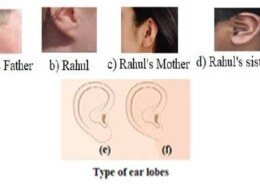Figures (a) to (d) given below represent the type of ear lobes present in a family consisting of 2 children – Rahul, Nisha and their parents.
Excited by his observation of different types of ear lobes present in his family, Rahul conducted a survey of the type of ear lobes found {Figure (e) and (f)} in his classmates. He found two types of ear lobes in his classmates as per the frequency given below:

On the basis of above data answer the following questions.
a) Which of the two characteristics – ‘free ear lobe’ or ‘attached ear lobe’ appears to be dominant in this case? Why?
b) Is the inheritance of the free ear lobe linked with sex of the individual? Give reason for your answer.
c) What type of ear lobe is present in father, mother, Rahul and his sister Nisha? Write the genetic constitution of each of these family members which explains the inheritance of this character in this family?
(Gene for Free ear lobe is represented by F and gene for attached ear lobe is represented by f for writing the genetic constitution).
OR
Suresh’s parents have attached earl obes. What type of ear lobe can be seen in Suresh and his sister Siya? Explain by giving the genetic composition of all.


Answer ( 1 )
a) Free ear lobe is dominant because it is found in a large majority of the population. (1)
b) No. It is not sex linked. As per the data of the family as well as the class, it is indicated that free ear lobe is present in males as well as in females. (1)
c) Father – Ff (free ear lobe), Mother – Ff (free ear lobe), Rahul – ff (attached ear lobe) and Nisha – Ff (free ear lobe)
OR
Suresh’s father – ff (attached ear lobe), mother – ff (attached ear lobe), Suresh – ff (attached ear lobe), Siya – ff (attached ear lobe). If both parents have recessive character, then all the children can have recessive character only.